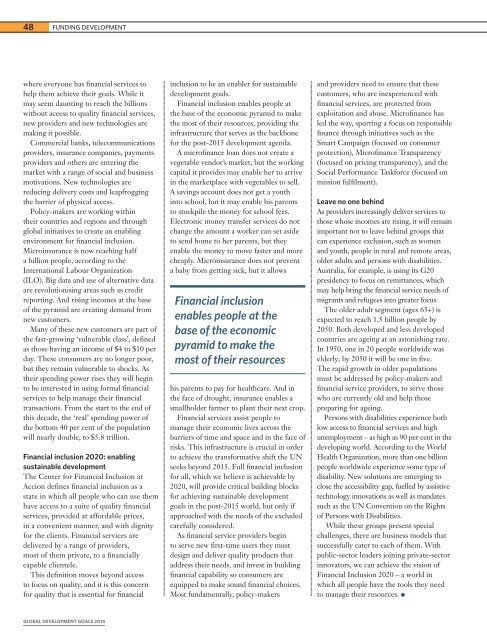FAMBB
FAMBB
FAMBB
Create successful ePaper yourself
Turn your PDF publications into a flip-book with our unique Google optimized e-Paper software.
48 FUNDING DEVELOPMENTwhere everyone has financial services tohelp them achieve their goals. While itmay seem daunting to reach the billionswithout access to quality financial services,new providers and new technologies aremaking it possible.Commercial banks, telecommunicationsproviders, insurance companies, paymentsproviders and others are entering themarket with a range of social and businessmotivations. New technologies arereducing delivery costs and leapfroggingthe barrier of physical access.Policy-makers are working withintheir countries and regions and throughglobal initiatives to create an enablingenvironment for financial inclusion.Microinsurance is now reaching halfa billion people, according to theInternational Labour Organization(ILO). Big data and use of alternative dataare revolutionising areas such as creditreporting. And rising incomes at the baseof the pyramid are creating demand fromnew customers.Many of these new customers are part ofthe fast-growing ‘vulnerable class’, definedas those having an income of $4 to $10 perday. These consumers are no longer poor,but they remain vulnerable to shocks. Astheir spending power rises they will beginto be interested in using formal financialservices to help manage their financialtransactions. From the start to the end ofthis decade, the ‘real’ spending power ofthe bottom 40 per cent of the populationwill nearly double, to $5.8 trillion.Financial inclusion 2020: enablingsustainable developmentThe Center for Financial Inclusion atAccion defines financial inclusion as astate in which all people who can use themhave access to a suite of quality financialservices, provided at affordable prices,in a convenient manner, and with dignityfor the clients. Financial services aredelivered by a range of providers,most of them private, to a financiallycapable clientele.This definition moves beyond accessto focus on quality, and it is this concernfor quality that is essential for financialinclusion to be an enabler for sustainabledevelopment goals.Financial inclusion enables people atthe base of the economic pyramid to makethe most of their resources, providing theinfrastructure that serves as the backbonefor the post-2015 development agenda.A microfinance loan does not create avegetable vendor’s market, but the workingcapital it provides may enable her to arrivein the marketplace with vegetables to sell.A savings account does not get a youthinto school, but it may enable his parentsto stockpile the money for school fees.Electronic money transfer services do notchange the amount a worker can set asideto send home to her parents, but theyenable the money to move faster and morecheaply. Microinsurance does not preventa baby from getting sick, but it allowsFinancial inclusionenables people at thebase of the economicpyramid to make themost of their resourceshis parents to pay for healthcare. And inthe face of drought, insurance enables asmallholder farmer to plant their next crop.Financial services assist people tomanage their economic lives across thebarriers of time and space and in the face ofrisks. This infrastructure is crucial in orderto achieve the transformative shift the UNseeks beyond 2015. Full financial inclusionfor all, which we believe is achievable by2020, will provide critical building blocksfor achieving sustainable developmentgoals in the post-2015 world, but only ifapproached with the needs of the excludedcarefully considered.As financial service providers beginto serve new first-time users they mustdesign and deliver quality products thataddress their needs, and invest in buildingfinancial capability so consumers areequipped to make sound financial choices.Most fundamentally, policy-makersand providers need to ensure that thesecustomers, who are inexperienced withfinancial services, are protected fromexploitation and abuse. Microfinance hasled the way, spurring a focus on responsiblefinance through initiatives such as theSmart Campaign (focused on consumerprotection), Microfinance Transparency(focused on pricing transparency), and theSocial Performance Taskforce (focused onmission fulfilment).Leave no one behindAs providers increasingly deliver services tothose whose incomes are rising, it will remainimportant not to leave behind groups thatcan experience exclusion, such as womenand youth, people in rural and remote areas,older adults and persons with disabilities.Australia, for example, is using its G20presidency to focus on remittances, whichmay help bring the financial service needs ofmigrants and refugees into greater focus.The older adult segment (ages 65+) isexpected to reach 1.5 billion people by2050. Both developed and less developedcountries are ageing at an astonishing rate.In 1950, one in 20 people worldwide waselderly; by 2050 it will be one in five.The rapid growth in older populationsmust be addressed by policy-makers andfinancial service providers, to serve thosewho are currently old and help thosepreparing for ageing.Persons with disabilities experience bothlow access to financial services and highunemployment – as high as 90 per cent in thedeveloping world. According to the WorldHealth Organization, more than one billionpeople worldwide experience some type ofdisability. New solutions are emerging toclose the accessibility gap, fuelled by assistivetechnology innovations as well as mandatessuch as the UN Convention on the Rightsof Persons with Disabilities.While these groups present specialchallenges, there are business models thatsuccessfully cater to each of them. Withpublic-sector leaders joining private-sectorinnovators, we can achieve the vision ofFinancial Inclusion 2020 – a world inwhich all people have the tools they needto manage their resources.GLOBAL DEVELOPMENT GOALS 2014


